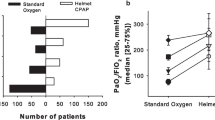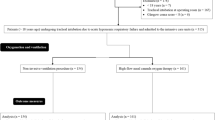Abstract
Purpose
The efficacy of noninvasive continuous positive airway pressure (CPAP) to improve outcomes in severe hypoxemic acute respiratory failure (hARF) due to pneumonia has not been clearly established. The aim of this study was to compare CPAP vs. oxygen therapy to reduce the risk of meeting criteria for endotracheal intubation (ETI).
Methods
In a multicenter randomized controlled trial conducted in four Italian centers patients with severe hARF due to pneumonia were randomized to receive helmet CPAP (CPAP group) or oxygen delivered with a Venturi mask (control group). The primary endpoint was the percentage of patients meeting criteria for ETI, including either one or more major criteria (respiratory arrest, respiratory pauses with unconsciousness, severe hemodynamic instability, intolerance) or at least two minor criteria (reduction of at least 30 % of basal PaO2/FiO2 ratio, increase of 20 % of PaCO2, worsening of alertness, respiratory distress, SpO2 less than 90 %, exhaustion).
Results
Between February 2010 and 2013, 40 patients were randomized to CPAP and 41 to Venturi mask. The proportion of patients meeting ETI criteria in the CPAP group was significantly lower compared to those in the control group (6/40 = 15 % vs. 26/41 = 63 %, respectively, p < 0.001; relative risk 0.24, 95 % CI 0.11–0.51; number needed to treat, 2) two patients were intubated in the CPAP group and one in the control group. The CPAP group showed a faster and greater improvement in oxygenation in comparison to controls (p < 0.001). In either study group, no relevant adverse events were detected.
Conclusions
Helmet CPAP reduces the risk of meeting ETI criteria compared to oxygen therapy in patients with severe hARF due to pneumonia.



Similar content being viewed by others
References
Sanz F, Restrepo MI, Fernández E et al (2011) Hypoxemia adds to the CURB-65 pneumonia severity score in hospitalized patients with mild pneumonia. Respir Care 56:612–618
Mandell LA, Wunderink RG, Anzueto A (2007) Infectious Diseases Society of America/American Thoracic Society consensus guidelines on the management of community-acquired pneumonia in adults. Clin Infect Dis 44(Suppl 2):S27–S72
Woodhead M, Blasi F, Ewig S et al (2011) Guidelines for the management of adult lower respiratory tract infections–full version. Clin Microbiol Infect 17(Suppl 6):E1–E59
Keenan SP, Sinuff T, Burns KE et al (2011) Clinical practice guidelines for the use of noninvasive positive-pressure ventilation and noninvasive continuous positive airway pressure in the acute care setting. CMAJ 183:E195–E214
Cosentini R, Brambilla AM, Aliberti S et al (2010) Helmet continuous positive air way pressure vs oxygen therapy to improve oxygenation in community-acquired pneumonia: a randomized, controlled trial. Chest 138:114–120
Squadrone V, Coha M, Cerutti E et al (2005) Continuous positive airway pressure for treatment of postoperative hypoxemia: a randomized controlled trial. JAMA 293:589–595
Squadrone V, Massaia M, Bruno B (2010) Early CPAP prevents evolution of acute lung injury in patients with hematologic malignancy. Intensive Care Med 36:1666–1674
Delclaux C, L’Her E, Alberti C (2000) Treatment of acute hypoxemic nonhypercapnic respiratory insufficiency with continuous positive airway pressure delivered by a face mask: a randomized controlled trial. JAMA 284:2352–2360
Fine MJ, Auble TE, Yealy DM et al (1997) A prediction rule to identify low-risk patients with community-acquired pneumonia. N Engl J Med 336:243–250
Lim WS, Baudouin SV, George RC et al (2009) Pneumonia Guidelines Committee of the BTS standards of care committee. BTS guidelines for the management of community acquired pneumonia in adults: ed 2009. Thorax 64(Suppl 3):iii1–iii55
Le Gall JR, Lemeshow S, Saulnier F (1993) A new Simplified Acute Physiology Score (SAPS II) based on a European/North American multicenter study. JAMA 270:2957–2963 (Erratum in JAMA 271:1321, 1994)
Jaber S, Michelet P, Chanques G (2010) Role of non-invasive ventilation (NIV) in the perioperative period. Best Pract Res Clin Anaesthesiol 24:253–265
American Thoracic Society; Infectious Diseases Society of America (2005) Guidelines for the management of adults with hospital-acquired, ventilator-associated, and healthcare-associated pneumonia. Am J Respir Crit Care Med 171:388–416
Ramirez JA, Srinath L, Ahkee S, Huang A, Raff MJ (1995) Early switch from intravenous to oral cephalosporins in the treatment of hospitalized patients with community-acquired pneumonia. Arch Intern Med 155:1273–1276
Ferrer M, Esquinas A, Leon M et al (2003) Noninvasive ventilation in severe hypoxemic respiratory failure: a randomized clinical trial. Am J Respir Crit Care Med 168:1438–1444
Navalesi P, Fanfulla F, Frigerio P et al (2000) Physiologic evaluation of noninvasive mechanical ventilation delivered with three types of mask in patients with chronic hypercapnic respiratory failure. Crit Care Med 28:1785–1790
Prinianakis G, Delmastro M, Carlucci A et al (2004) Effect of varying the pressurisation rate during noninvasive pressure support ventilation. Eur Respir J 23:314–320
Plant PK, Owen JL, Elliott MW (2000) Early use of non-invasive ventilation for acute exacerbations of chronic obstructive pulmonary disease on general respiratory wards: a multicentre randomised controlled trial. Lancet 355:1931–1935
Kelly BJ, Matthay MA (1993) Prevalence and severity of neurologic dysfunction in critically ill patients. Influence on need for continued mechanical ventilation. Chest 104:1818–1824
Confalonieri M, Potena A, Carbone G et al (1999) Acute respiratory failure in patients with severe community-acquired pneumonia. A prospective randomized evaluation of noninvasive ventilation. Am J Respir Crit Care Med 160:1585–1591
L’Her E, Deye N, Lellouche F et al (2005) Physiologic effects of noninvasive ventilation during acute lung injury. Am J Respir Crit Care Med 172:1112–1118
Mariani J, Macchia A, Belziti C et al (2011) Noninvasive ventilation in acute cardiogenic pulmonary edema: a meta-analysis of randomized controlled trials. J Card Fail 17:850–859
Principi T, Pantanetti S, Catani F et al (2004) Noninvasive continuous positive airway pressure delivered by helmet in hematological malignancy patients with hypoxemic acute respiratory failure. Intensive Care Med 30:147–150
Corrado A, Roussos C, Ambrosino N et al (2002) European Respiratory Society Task Force on epidemiology of respiratory intermediate care in Europe. Respiratory intermediate care units: a European survey. Eur Respir J 20(5):1343–1350
Dellinger RP, Levy MM, Rhodes A et al (2012) Surviving Sepsis Campaign Guidelines Committee including The Pediatric Subgroup. Surviving Sepsis Campaign: international guidelines for management of severe sepsis and septic shock, 2012. Intensive Care Med 39:165–228
Acknowledgments
The authors acknowledge the assistance of Tommaso Maraffi, MD (Emergency Medicine Department, IRCCS Fondazione Ca’ Granda, Ospedale Maggiore Policlinico, Milan, Italy). RC takes responsibility for the content of the manuscript, including the data and analysis. Conception and design: RC, AMB, SA, AB, PP; analysis and interpretation: RC, AMB, SA, AB, EP, SN, GF, PP, PT; drafting the manuscript for important intellectual content: RC, AMB, SA, AB, EP, SN, GF, PP, FN, MDF, FC, PT. Funding: Research grant from the IRCCS Fondazione Ca’ Granda, Ospedale Maggiore Policlinico, Milan, Italy.
Conflicts of interest
On behalf of all authors, the corresponding author states that there is no conflict of interest.
Author information
Authors and Affiliations
Corresponding author
Additional information
Take-home message: Our results show a reduction of the risk of meeting criteria for intubation with helmet CPAP in comparison to oxygen therapy in severe hARF due to pneumonia. Helmet CPAP also promotes a faster and greater improvement in oxygenation, with no relevant adverse events during treatment.
Electronic supplementary material
Below is the link to the electronic supplementary material.
Rights and permissions
About this article
Cite this article
Brambilla, A.M., Aliberti, S., Prina, E. et al. Helmet CPAP vs. oxygen therapy in severe hypoxemic respiratory failure due to pneumonia. Intensive Care Med 40, 942–949 (2014). https://doi.org/10.1007/s00134-014-3325-5
Received:
Accepted:
Published:
Issue Date:
DOI: https://doi.org/10.1007/s00134-014-3325-5




